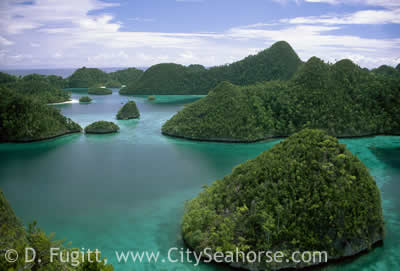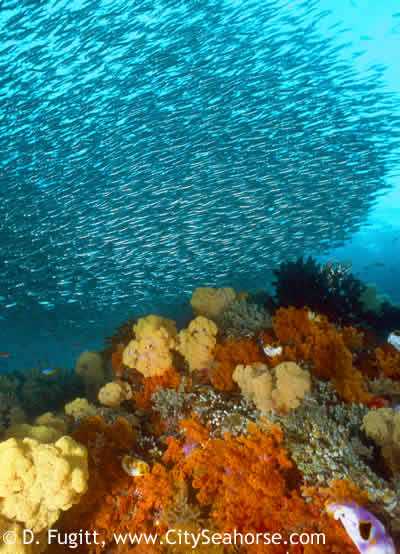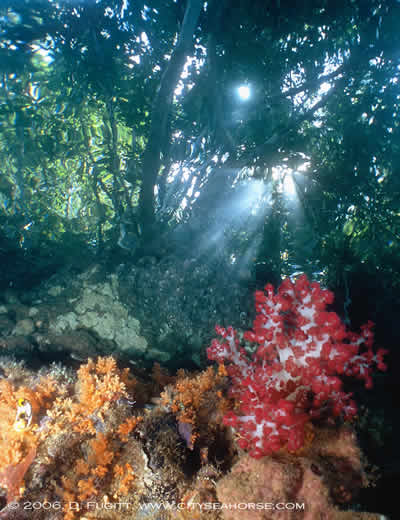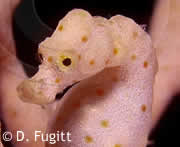 Raja Ampat, the "Four Kings" lies off the northwest tip of New Guinea Island. This small area, part of the Indonesian province of Papua, is sprinkled with hundreds of rock islands and reefs. Raja Ampat, the "Four Kings" lies off the northwest tip of New Guinea Island. This small area, part of the Indonesian province of Papua, is sprinkled with hundreds of rock islands and reefs.
» See Raja Ampat Maps
» Indonesia map showing Raja Ampat
Whereever you go in Raja Ampat the topside scenery is outstanding.
There are rock island lagoons where you need a guide or would be lost!; white sand beaches with the most powdery white sand you'll every see and no people!; jungly rainforests full of exotic birds and marsupials; and picturesque tiny islands surrounded by turquoise lagoons.
Sunrises and sunsets can be amazing... and you should experience the stars at night! We sit on the top deck of our liveaboard underneath skies blazing from horizon to horizon with stars. Also an amazing surface ending to a night dive!
Waters are unbelievably warm (28-30C / 82-86F) and calm, often with seas mirroring the blue sky and fluffy clouds, making your diving and cruising days very comfortable.
 Raja Ampat's Diving - Variety Raja Ampat's Diving - Variety
The highlight of Raja Ampat's diving is variety.
Reefs, muck dives, walls, pinnacles, piers & jetties, narrow shallow channels, walls.... You can expect to see everything from gorgeous reefs spilling over with colorful corals and small reef fishes to black sand slopes and their odd denizens such as the Mimic Octopus, Pygmy Cuttlefish, Ornate Ghost Pipefishes, Solar Powered Nudibranchs and snake eels.
Some dives are fish soup with mind boggling scenes containing many species of schooling and solitary fishes as well as giant clams and Tasselled Wobbegong Sharks (carpet sharks).
Other dives are full of tiny creatures such as pygmy seahorses (multiple varieties), nudibranchs, pipefishes, lionfishes, shrimps, juvenile fish, shells (such as the allied cowrie that lives on soft corals), tiny gobies and blennies.
There are certainly better places if your focus is narrow (such as Cocos for sharks, or Lembeh Strait for strictly muck diving) but for variety with every day a bit different, it's Raja Ampat's diversity that makes it amazing. Our guests come home with the largest variety of images of any single trip they have ever taken.
 Raja Ampat's Diving - Depths Raja Ampat's Diving - Depths
We typically do not need to dive deep in Raja Ampat.
Due to the lack of storm activity, the tops of the reefs are colorful, full of corals and life. In many cases corals and small creatures are found right up to the surface!
For this reason (many shallow areas) our divers often make 4-5 very long dives each day. On our value added trips, there is no limit on dive time and often we take entire days to let you dive when and as much as you like.
On one site my typical maximum depth is less than 17 ft. (see photo on right). In fact, some of the best underwater photography and video opportunities are shallow, in less than 25 ft. of water.
For underwater video shooters there are plenty of colorful corals and fishes in the shallows. With the sunlight on the shallow dive sites, some awe inspiring video sequences are possible.
Some Raja Ampat dive sites do require diving a bit deeper in order to stay out of the current. 50-80ft would be a typical deepest depth on those dive sites with the top of the reef at 15-20 ft.
There are a few dive sites where there is a reward for going deeper, such as following the top of the reef out and down to see massive schools of fishes.
The Diving - Critters
I'm sure you've read about Raja Ampat's marine life diversity.
For several years now, Raja Ampat has been in the diving news and on TV programs with heavy concentation on the increasing counts of different and new species found in the area.
One reason for this diversity is the number of different habitats in the area, which also creates many diverse opportunies for underwater photography.
No where else I've
dived offers such consistent
mind boggling vistas of fish and
corals. Yet, focusing down to a
smaller level there are macro
creatures galore.
Dr Gerald Allen declared that "Raja Ampat
represents the bulls-eye of
biodiversity in coral reefs" and
recommended "we protect
the reef at all costs, because
it represents the baseline to
which all other reefs in the world be compared".
In my mind, some dive sites in Raja Ampat are "Wide Angle" sites, while others are "Macro" sites, but often a site can be both. Come prepared to create the biggest variety of underwater images of any dive trip you've ever made.
For macro, here are a few ideas of what you will see while diving in this area:
- Colorful backgrounds of tunicates, crinoids and soft corals that are host to allied cowries, sawtooth shrimps, gobies, squat lobsters, pygmy seahorses and nudibranchs.
- Black sand slopes that are home to unusual octopus: the Mimic, the Wonderpus; Pygmy Cuttlefish, snake eels, Robust and Ornate Ghost Pipefish, soft corals with swarms of tiny porcelain crabs and shrimps, sand anemones with their anemonefishes, crabs and shrimps, graceful tube anemones.
- White sandy areas with the Twin Spot (Crab Eye) gobies, colorful variants of scorpionfishes, skeleton shrimp, Flamboyant Cuttlefish, Devil Scorpionfish, Winged Pipefish, shrimp gobies...
- Reefs full of colorful reef fishes, butterflyfish, angelfish, many species of anemonefish, frogfish, sweetlips, graceful batfish.
- Shallow mangrove and rainforest areas with their archerfish, juvenile batfish, estuarine half beaks, and hovering cardinalfishes.
- Night dives with the nocturnal crowd: the Walking Shark (Raja Ampat Epaulette Shark), False Scorpionfish, seahorses, hairy octopus, hunting lionfish, decorator crabs, hermit crabs, Spanish Dancers, eels.
The list is too long! On every trip I make to Raja Ampat I see some creature I've never seen before. The diving is continuously amazing, always exciting and entices me back again. Even though I've dived the same sites dozens or hundreds of times, it is always different.
The Diving - Wide Angle Scenery
The best place for wide angle photography I've found!
In Raja Ampat its not about finding a great subject for wide angle photography, it's about deciding which is most worthy of your time.
While some dives are obviously for poking about finding tiny creatures, many are packed with the most colorful variety of soft corals, fans and hard corals I've seen. Since there are also many fish I often find a beautiful coral scene and wait for the fish to come and create an interesting composition.
With the underwater topology aournd the rock islands full of swim throughs, mushroom shapes, cracks and pinnacles, images with these shapes as background, perhaps with a model, often adorn the covers of dive books and magazine issues. Schools of sweelips posing with soft coral covered bommies, large schools of fish intersecting with schools of another species, shots from inside shallow caves, shallow shots looking up throug the surface to rainforest above... there are many possibilties.
Water Temperature & Recommended Wetsuits
Warm warm water!
The waters of Raja Ampat are unbelievably warm with an underwater temperature year round ranging from (28-30C / 82-86F) depending on the dive site. This is some of the most consistently warm water you'll ever have the pleasure to dive.
Most divers require only a skin or 1mm wetsuit, although a few people who get cold very easily will wear 5mm!
We dive all day long in 1mm neoprene suits and bring along a polypro or lycra hood and a 3mm vest to wear in case we do get chilled on dive sites where we spend a lot of time underwater during one day.
There is one dive site where I know I'll be underwater so many hours that I start with a 3mm suit, and then prepare it for packing after we leave the area!
Without a thick wetsuit to impact buoyancy, the diving is much easier and less tiring. |

 Raja Ampat, the "Four Kings" lies off the northwest tip of New Guinea Island. This small area, part of the Indonesian province of Papua, is sprinkled with hundreds of rock islands and reefs.
Raja Ampat, the "Four Kings" lies off the northwest tip of New Guinea Island. This small area, part of the Indonesian province of Papua, is sprinkled with hundreds of rock islands and reefs.
 Raja Ampat's Diving - Variety
Raja Ampat's Diving - Variety Raja Ampat's Diving - Depths
Raja Ampat's Diving - Depths 
